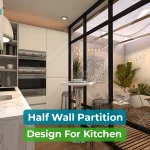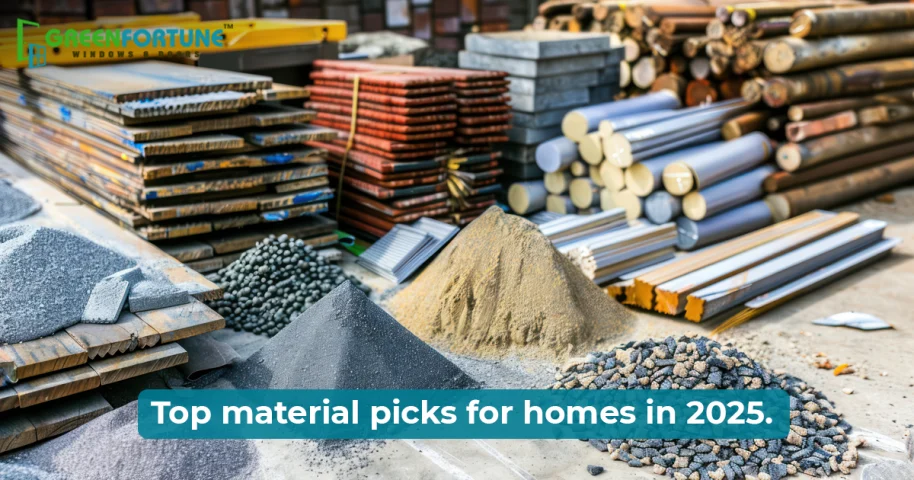
You Won’t Believe These Stylish Kitchen Partition Design Ideas Exist
June 23, 2025
Home Entryway Interior Design Ideas That Make a Great First Impression
June 24, 2025Building your dream home is one of the most exciting journeys in life. But let’s face it—it can also feel overwhelming, especially when it comes to choosing the right materials. With so many options out there, how do you pick the best material for home construction?
Well, you’ve come to the right place. In this blog, we’ll break it all down for you. We’ll look at common options, what works best in different climates, what lasts longest, and what gives you the best bang for your buck.
Whether you're working with an architect or doing your own research, this guide will help you make smarter choices
Why the Right Material Matters
Before we dive into the building materials list, let’s talk about why your choice matters so much.
- It affects your home’s strength and safety.
- It impacts how much maintenance you’ll need.
- It determines how well your house handles the local climate.
- It even plays a role in resale value and energy savings.
Choosing the best material for home construction isn’t just about looks or price—it’s about creating a home that lasts, feels comfortable, and fits your lifestyle
1. Concrete: Strong, Steady, and Popular
Concrete is one of the most widely used materials in the world, and for good reason. It’s super strong, fire-resistant, and lasts a very long time. For people who want a home that feels solid and safe, concrete is a great choice.
Pros:
- Excellent durability
- Good for soundproofing
- Great in most weather conditions
Cons:
- Can be expensive
- Needs skilled labor
- Not the best insulator unless paired with other materials
Best for: Cities, earthquake-prone areas, modern-style homes
2. Brick: Classic and Timeless
If you’re someone who loves a traditional look, brick might be your go-to. It’s been around for centuries and is still a favorite on many building materials list today.
Pros:
- Great at handling heat
- Low maintenance
- Long-lasting
Cons:
- Can crack in freezing temperatures
- Heavier than other materials
- Labor-intensive to build with
Best for: Warm, dry climates or homes with a classic design
3. Wood: Warm, Natural, and Flexible
Wood has a charm that no other material can match. It feels cozy, looks beautiful, and works well in many settings. It’s often used in cabins, beach homes, and suburban houses.
Pros:
- Easy to work with
- Naturally insulating
- Gives a warm, rustic look
Cons:
- Prone to termites and rot if not treated
- Not fire-resistant
- Needs regular maintenance
Best for: Dry climates, eco-conscious builds, and cozy aesthetics
4. Steel: Modern and Mighty
Looking for durable construction options that can handle almost anything? Steel might be your answer. It’s becoming more popular for residential use thanks to its strength and modern vibe.
Pros:
- Very strong
- Resistant to pests and mold
- Recyclable and eco-friendly
Cons:
- Can rust without proper coating
- Poor insulation unless combined with other materials
- Usually more expensive
Best for: Industrial-style homes, hurricane zones, or places needing high structural integrity
5. Stone: Natural and Nearly Indestructible
Stone homes aren’t as common these days, but they’re still an excellent option for people wanting beauty and toughness combined. Think mountain retreats or Mediterranean villas.
Pros:
- Extremely durable
- No need for painting
- Fire and weather-resistant
Cons:
- Expensive
- Heavy and hard to work with
- May need extra insulation
Best for: Cold or hilly areas, timeless architecture lovers
6. Mud, Clay, and Adobe: Eco-Friendly and Earthy
These might sound old-school, but they’re making a comeback in sustainable building trends. Especially when choosing climate-based house materials, adobe and clay are fantastic in hot, dry places.
Pros:
- Natural temperature control
- Low environmental impact
- Affordable in the right regions
Cons:
- Not suitable for wet climates
- Takes time to build and cure
- Needs protective layers to prevent erosion
Best for: Dry, warm climates and eco-friendly builds
Climate Matters: Choose Smart
Choosing the best material for home construction isn’t just about the material itself—climate plays a huge role. Let’s break it down quickly:
Climate Type | Recommended Materials |
Hot and Dry | Adobe, brick, clay, and concrete |
Cold and Snowy | Stone, insulated wood, and concrete with an extra layering |
Humid or Rainy | Treated wood, steel, and concrete |
Hurricane or Earthquake Zones | Steel, reinforced concrete, fiber cement |
Always look into climate-based house materials that fit your local weather to avoid damage and reduce energy bills.
Let’s Talk Costs: Budget vs Long-Term Value
Of course, your budget will affect your choice. But don’t just look at the initial price tag. Think about long-term maintenance, energy savings, and how long the material will last.
Material | Initial Cost | Maintenance | Lifespan |
Concrete | High | Low | 50+ years |
Brick | Medium | Low | 50+ years |
Wood | Low to Medium | High | 30–50 years |
Steel | High | Low | 50+ years |
Stone | High | Very Low | 100+ years |
Adobe | Low | Medium | 30–50 years |
If you're planning to live in your home long-term, it’s often worth spending a little more upfront on a durable construction option that will save you headaches down the road.
Mix and Match Materials
You don’t have to choose just one material. In fact, many dream homes use a mix. For example, you might have:
- A concrete foundation
- Brick exterior walls
- Steel roof supports
- Wooden interiors
Combining the best material for home construction with others creates a balance between looks, function, and cost.
Bonus: New-Age Materials to Watch
Modern technology is changing the way we build homes. Here are some cool materials making their way into future homes:
- Bamboo: Sustainable, strong, and beautiful
- Fiber cement: Fireproof, low-maintenance, and weather-resistant
- Insulated concrete forms (ICF): Energy-efficient and quiet
- Structural Insulated Panels (SIPs): Pre-made panels that save time and energy
These are worth considering if you’re looking for smart, green alternatives.
Final Thoughts
So, what’s the best material for home construction? The truth is, there’s no one-size-fits-all answer. It depends on your climate, budget, style, and long-term plans.
That’s why it’s important to explore your building materials list, think about durable construction options, and look into climate-based house materials. Your dream home should not only look good—it should feel right, stand strong, and suit your everyday life.
Take your time, ask questions, and talk to your builder or architect. You’re not just picking materials—you’re creating the space where your life will happen. And that’s a decision worth doing right.
Keep Your Home Quiet and Comfortable
GreenFortune’s uPVC windows and doors help keep outside noise, dust, and heat out of your home. Whether you live in a busy city or a calm area, you’ll notice the difference right away. It’s the perfect way to enjoy peace and quiet while also saving energy.
Check out the full range at GreenFortune and give your home a smart and stylish upgrade that lasts for years.
FAQs
- Is it possible to combine traditional and modern materials when building a home?
Yes, combining traditional materials like brick or wood with modern ones like steel or fiber cement is not only possible but also practical. It helps you achieve both aesthetic appeal and structural strength. Many architects now recommend hybrid designs for better performance and energy efficiency.
- Which materials are best for soundproofing a home?
Concrete and brick are excellent for blocking noise due to their dense structure. You can also add insulation layers, acoustic panels, or soundproof windows for better results. When choosing the best material for home construction, consider sound control if you live in a noisy area.
- How do eco-friendly materials compare to conventional ones in performance?
Eco-friendly materials like bamboo, rammed earth, or insulated concrete forms often match or exceed the performance of traditional materials. They provide better thermal efficiency and reduce environmental impact. These options are becoming popular among homeowners who value sustainability without compromising durability.




